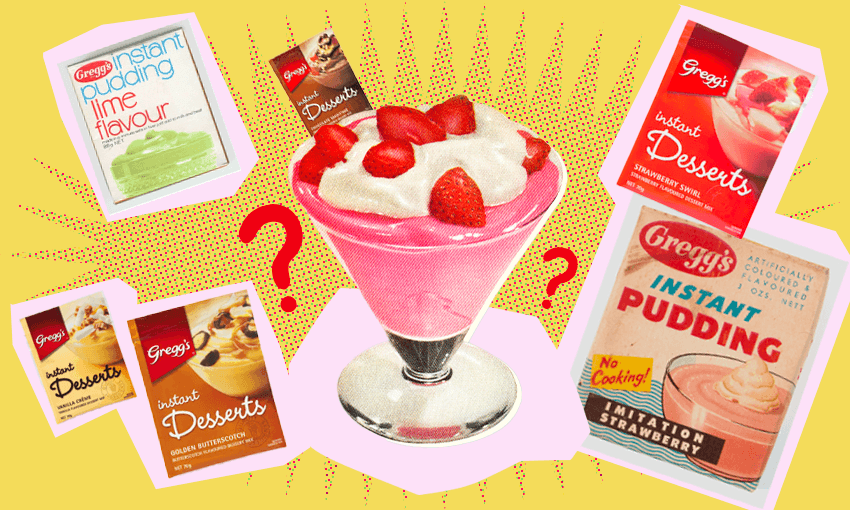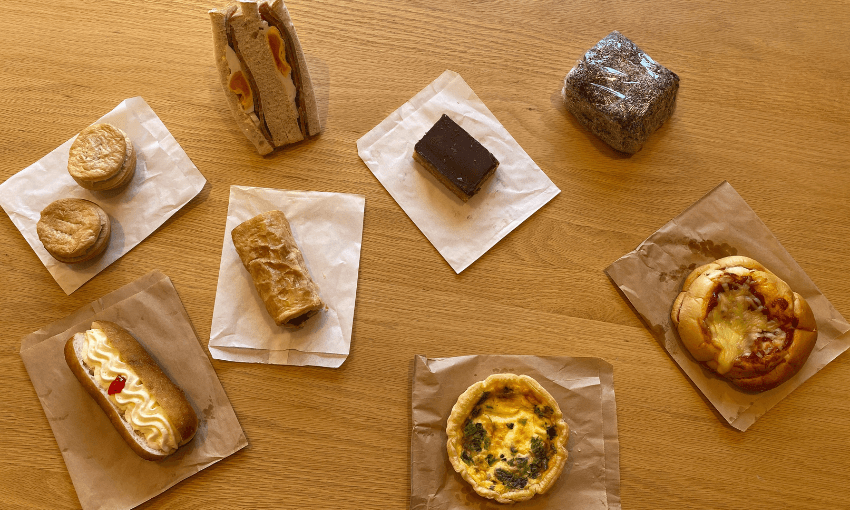They were a pantry mainstay for more than half a century – but there are signs that instant puddings are on their way out.
As a child, it was about as close to real magic as I’d ever seen. The powdered contents of a sachet of “Gregg’s instant desserts: strawberry swirl” miraculously transformed, by way of milk and an egg beater, into a pink-hued gloop with the most wondrously artificial of flavours. No wand required.
These no-fuss, no-mess puddings, set in the fridge within individual squat sherbet glasses, occupy an especially vivid part of my memory of the early-2000s. At the supermarket, the sachets were found in the same aisle as the syrups, rainbow-hued ice cream cones, and raspberry JJ wafers. They were always and without fail situated adjacent to their kindred culinary spirit, instant jelly crystals.
Now when I walk down the same aisle at my local supermarket there’s an absence. The jellies remain, but where are their old pudding mates?
To be clear, some New World and Pak’nSave supermarkets do still sell a selection of the last four flavours of Gregg’s instant pudding in production: chocolate, butterscotch, vanilla and strawberry. But at Countdown, you’re out of luck no matter which supermarket you visit.
In an email, a Countdown spokesperson confirmed the end of Gregg’s instant puddings in their stores: “We stopped stocking the range around July last year,” they wrote – adding, tragically, that “until now we haven’t had any customer feedback about the decision.”
Perhaps more striking than the fact that one of our three major supermarkets has ceased selling instant puddings is the unbothered response from their customers. It speaks to the sad, quiet twilight of a product that for almost 70 years was ubiquitous in kitchen pantries across Aotearoa.
Instant pudding mix was first introduced by US brand My-T-Fine in 1918. The novel sugar and cornflour mix, made to be mixed with milk (a notably similar concept to British-invented custard powder), was a product of the post-World War One manufacturing boom, with assembly lines and labs beginning to take over more and more of America’s cooking. It was the rise of supermarkets in the US and the growing number of women entering the workforce that propelled instant pudding’s popularity as a convenient dessert.
Locally, the earliest mention of instant pudding in New Zealand newspapers is from a 1934 issue of the Hokitika Guardian, where an advertisement for Fairlies Discount supermarket advertises them at three for three shillings.
More than 20 years later, in 1955, a column in The Press advertised a “new” product described “a boon to every busy mother!” Gregg’s instant pudding came in “three thrilling flavours” – butterscotch, vanilla and chocolate. Operating since 1861, Gregg’s – which has sold coffee, spices, jelly crystals, salad dressing and seameal custard – is one of New Zealand’s oldest food companies.
Instant puddings emerged in an Aotearoa where dessert was a compulsory part of many people’s everyday evening meal, explains food historian and archaeologist David Veart. “In our house, [pudding] was almost always there; plum jam pies, quick butter pastry with homemade plum jam complete with ‘tinker, tailor’ stones,” he says. Still, most things were made from scratch then, so these puddings were “‘instant’ at a time when there were very few commercial shortcuts,” he says.
Over the next half-century, local brands like Lushus, Edmonds and Hansells would also produce a variety of instant puddings, desserts and mousses in an astonishing array of imitation flavours, including jaffa, banana, lime, lemon, coconut, caramel, orange and raspberry. While earlier ideas around puddings adhered to the boiled and baked norms of British tradition, these sweets saw distinctions blurred through an acceptance of American notions of “pudding” – something sweet, milky and smooth-textured, akin to a custard. The concept of cooking transformed too, with traditional methods – measuring, beating, slicing, mashing, boiling, carving – dismissed as old-fashioned drudgery. Now, meals would practically cook themselves – in the case of pudding, all it took was opening a box. “Quick, easy, no cooking, no cooling,” declared a Gregg’s instant pudding advertisement from the 1950s.
Veart points to instant pudding’s use of milk as a link to our dairy-heavy food history. “Milk is one of Aotearoa’s food staples – even our mayonnaise was made from condensed milk,” he says. “It is not for nothing we call our corner shops ‘dairies’.” Slight modifications in the instructions on the back of Gregg’s instant pudding packages reflect changing domestic technologies too. While more contemporary packets call for the mix to be refrigerated, earlier versions, from a time when fridges were less common, suggest the pudding simply be left at room temperature to set.
But after more than half a century of popularity, their star seems to be fading – and not just in New Zealand. A New York Times article from January this year notes that sales of gelatin and pudding mix had declined by 5.9% in December 2022 compared with the year prior.
“I remember so many instant puddings through my childhood and I remember the chocolate one being so light and fluffy – it makes me crave it,” says cookbook author and Great Kiwi Bake Off runner-up Naomi Toilalo (Ngāti Porou). “We’d always have those little packets in the cupboard and if ever you had something on or you wanted to do something easy for a dessert you could just whip one of those up.”
For these once-beloved shortcut desserts to remain relevant, Toilalo believes they need some kind of purposeful revival. “We need to see how it can be used in the modern day: Can you chuck it on top of a pavlova? Can you put it in a layered dessert situation?” she says. “Bring it back, let’s see how we can use it in different ways – that is the key to a lot of these old-school products surviving.”
Jordan Rondel, owner of The Caker and a Great Kiwi Bake Off judge, agrees. Rondel’s cakes – often filled with fresh fruit, made with polenta and olive oil, and likely to be dripping with lemon curd, chopped pistachios and rose petals – are a stark contrast to the synthetic abundance of the instant pudding era. Perhaps unsurprisingly, Rondel has never actually tried an instant pud herself. “When I got into baking, I was very much all about, everything you use is natural, and high quality. And so I guess I just avoided it somehow.”
Rondel sees the potential demise of instant puddings as a reflection of changing tastes and cooking styles in Aotearoa. “It’s all about consumer trends changing and us being more aware of what we’re putting into our bodies.”
Living between Los Angeles and Auckland, Rondel has noticed that artificially flavoured, boxed food remains prevalent in the US. That culture of convenience sparked her own foray into the world of box cake kits, although hers are a little different to the versions most of us would be familiar with, featuring flavours like lemon strawberry poppy seed, and spiced carrot with salted caramel. Still, she sees parallels between her box cake mixes and the potential to adjust instant puddings to evolving tastes. “It’s about taking what’s considered to be kind of a crappy product and putting it in a whole new outfit,” she says.
There are suggestions that might already be the way the product is moving – Countdown stocks instant pudding equivalents in the form of powdered raspberry panna cotta by freeze-dried fruit brand Fresh As, as well as a “French style” crème brûlée, “Italian style” panna cotta, and chocolate-flavoured mousse by Hansells. You could describe them as elevated instant puddings.
“The ingredients in my cakes are really good and the recipes are so considered that the fact that it’s made out of a packet is not really a detriment,” Rondel says. “So maybe we should look at these instant puddings in the same way.”
This week, Rondel has been researching the potential benefits of instant pudding within her own cake making process – and has since ordered packets of vanilla Jello instant pudding to experiment with. “It’s certainly not just about making an instant pudding from an instant pudding mix, it’s more about using it in other dessert elements to elevate that dessert,” she says.
Since their inception, instant puddings have been added to other desserts like cakes, trifles, cookies, cheesecakes, icings and creams to improve texture, add moisture, produce a taller rise and to help creations last. “The beauty of it, from what I understand, is it contains starch, but it’s a modified starch,” says Rondel. “That means it can react without any heat, so you could use it in whipped cream or in a pastry cream and get it to really hold up and last well.”
The initial plan is to add the powder to a mascarpone icing which tends to suffer from water separation over time. The proof will quite literally be within the pudding as to whether it helps with longevity, especially as the weather in Los Angeles heats up and wedding season begins.
“It sounds like it does magical things. I’m really, really eager to try it,” Rondel says. “It’s a whole new world.”
Thanks to food historian Duncan Galletly for additional information on the history of instant pudding in Aotearoa.





